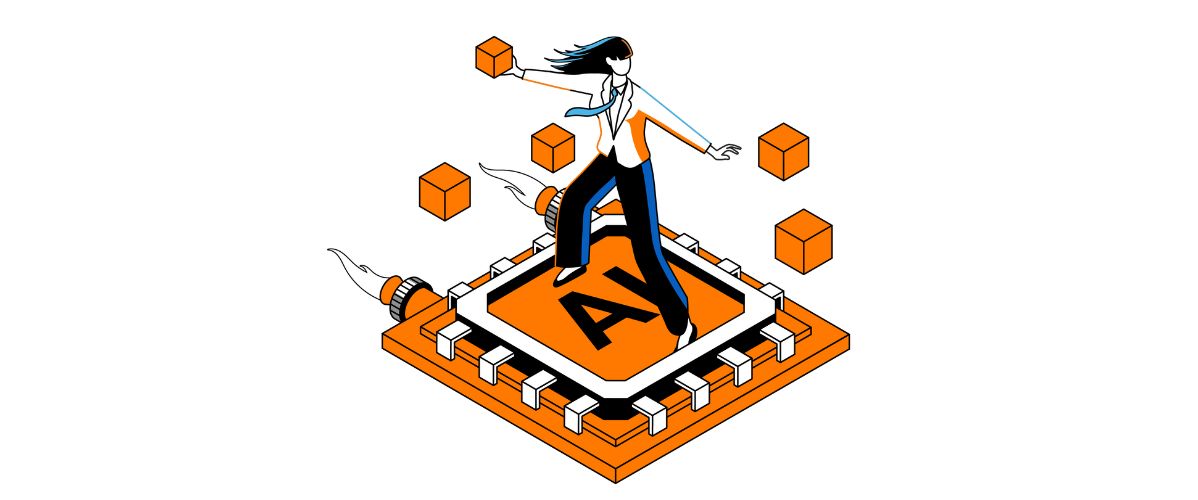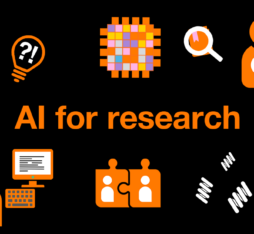• We are now seeing the emergence of complex AIs, notably generative, multimodal, agentic and adaptive systems, which are combining modes of perception, and operating with increasing levels of autonomy to accomplish an ever-growing number of various and contextualised tasks. All of these innovations are bringing us closer to the as yet theoretical goal of the creation of a general AI, which will be able to reason and reproduce human cognition.
• This lexicon lists in the order of their appearance different types of artificial intelligence and modes of interaction with AI, which are now being integrated in the architecture of complex systems. Orange utilizes all of these variants and interfaces in several hundred telecom operator use cases, to improve the quality of networks, enhance customer experience and boost operational efficiency.
Symbolic AI
The dominant approach in the 1970s, symbolic AI is based on human-coded logical rules that underlie its ability to reason. It has notably been used to develop expert systems, particularly for medical diagnosis. Unlike connectionist AI, it uses structured information and graphs to model human behaviour and make inferences. This rigid approach is now enjoying a revival buoyed by a renewed interest in hybrid systems (see below).
- Example: medical diagnostic systems such as MYCIN.
- Challenges and limitations: rigidity and difficulty managing uncertainty and complexity.
Statistical or Bayesian AI
Based on probabilities, statistical AI models uncertainty, that is to say that it predicts and classifies uncertainties. A Bayesian approach which uses Bayes’ theorem to integrate a priori knowledge and empirical data, it excels at generating inferences and robust predictions. Rarely used alone in modern systems, it nonetheless plays an important role in risk analysis and predictive applications.
- Example: anti-spam filtering for email.
- Challenges and limitations: requires large quantities of data to be effective.
Connectionist AI
The technology behind modern deep learning, connectionist AI is inspired by the structure of the human brain, which it imitates with artificial neural networks. These learn by adjusting the weights of connections between neurons that are arranged in layers. Connectionist AI has enabled scientists to create machine translation systems and it is also the technology behind AI services deployed by such companies as Google/DeepMind, OpenAI, etc.
- Example: computer vision, natural language processing (NLP).
- Challenges and limitations: high energy consumption (for computation) and lack of transparency and explainability.
Generative AI
Wildly popular in recent years, generative AI processes massive amounts of data to produce text, images, videos, and computer code in response to user instructions known as prompts. Google (the inventor of generative approaches) along with such start-ups as OpenAI, Mistral, and Anthropic, and a number of Chinese players (notably DeepSeek) is leading the drive to develop this technology, which nonetheless suffers from one inherent problem: the manner in which it generates results is not transparent.
- Example: generation of text with ChatGPT and images with Dall-E.
- Challenges and limitations: energy consumption, occasional hallucinations, biases and hijacking for abusive and illegal purposes such as disinformation (fake news).
Users can interact with generative AI via multiple interface modes (multimodality) and results can be combined in several different document types (omnimodality).
Note: AI can also interact with other computer systems without human involvement, via application programming interfaces (APIs).
Multimodal AI
It can handle and combine text, images, audio, and video. Examples include GPT-4o Vision and Gemini. In other words, multimodal AI analyses different types of data inputs to improve its processing accuracy and generate more effective outputs.
- Example: spoken responses to questions.
- Challenges and limitations: the complexity of integrating multiple modalities.
Omnimodal AI
It handles all types of data, for both input and output. Still in development, it is an important goal in research on the creation of “unified AI” systems that can power universal, multitasking assistants. Rather than just reading text or analysing images with modalities in distinct silos, an omnimodal AI can perform all these tasks concurrently, and thus watch video, while listening to sound, and reading subtitles to achieve a more holistic interpretation of data.
- Example: deployed in the insurance sector, omnimodal AIs could analyse emails, damage photos, voice calls and documents from single input to facilitate the evaluation of claims.
- Challenges and limitations: complexity and high development costs.
Agentic AI
Agentic AI refers to an architectural framework (covering both technical implementation and functional design) for building agents and multi-agent systems that can autonomously plan, execute, and learn. Its successful implementation is seen as the holy grail for the automation of professional tasks. Such systems, which have an awareness of their environment, can set goals, devise action plans, operate independently, and work in isolation or interact with other agents and humans. AI agents equipped with reasoning abilities and contextual memory, have the capacity to take charge of proactive, closed-loop decision-making.
- Example: Automatic report generation: the AI fetches data from your tools (Excel, Notion, Google Analytics, etc.), generates graphs and a summary, and sends the report to your team via email.
- Challenges and limitations: security and maintaining control over autonomous initiatives.
Embedded AI
Operating locally and not reliant on the cloud, these embedded AI systems are integrated in devices such as smartphones, cars, robots, and certain sensors. Destined to play a crucial role in IoT (Internet of Things), healthcare, and connected devices, which require lightweight adaptable AI models, they process data in real-time, with less latency, more privacy, and better energy efficiency, while reducing dependence on network quality.
- Example: intelligent sensors in autonomous vehicles.
- Challenges and limitations: reduced processing power and storage capacity.
Note: embedded AI is often seen as subset of Edge AI, which is deployed on the periphery of the cloud with a view to achieving lower latency and enhanced security
Federated AI
A form of distributed or decentralized AI with a distinct procedure for model training. It consists of leaving data on local machines (e.g., smartphones, hospital servers, IoT devices), which only send model updates to a central server. The goal is to facilitate training without ever centralizing data, in order to reinforce confidentiality, security, and regulatory compliance (such as GDPR).
- Example: predictive text on smartphones, AI analyses of medical data for drug development.
- Challenges and limitations: the complexity of coordination between nodes.
Adaptative AI
These are systems that make use of continuous incremental learning to adapt over time to environments and users. Unlike more conventional models that require complete training at regular intervals, they can maintain their performance in changing situations by automatically recalibrating, i.e. they can autonomously adjust their structure, parameters and behaviours when they detect a drop in performance, a change in context or the arrival of new data.
- Example: dynamic video games and robot companions.
- Challenges and limitations: unpredictability and a limited ability to adapt to rapid change.
Hybrid AI
These systems combine symbolic AI and connectionist AI (based on deep learning) to leverage the strengths of both paradigms: symbolic AI’s explicit comprehension and explainable reasoning, and better performance and efficiency thanks to deep learning.
- Example: A medical assistant that uses a language model to understand symptoms, coupled with a system capable of checking drug interactions.
- Challenges and limitations: the complexity of integrating different approaches.
Weak AI vs Strong AI… and the drive to achieve AGI?
Weak AI — which we currently have: ChatGPT is an example – is designed to accomplish specific tasks but lacks a holistic understanding of reality. In contrast, strong AI, which as yet remains a theoretical concept, should be capable of understanding and adapting to any situation. As such, it is viewed as a key milestone in the drive to achieve AGI or General AI (not to be confused with Generative AI), which is expected to deliver systems that can understand, learn, and adapt to any human cognitive task, with a level of performance that is equal to or superior to human abilities. Needless to say, such systems have not yet been developed.
- Example: we may at some point be able to ask AGI to develop complex strategies to address the need to limit global warming to two degrees. In response, it could combine vast quantities of data from satellite imagery and the analysis of economic policy and human behaviour to model different outcomes and recommend initiatives to governments, NGOs and companies.
- Challenges and limitations: as it stands, the efficient modelling of conscience and common sense, the successful development of unsupervised general learning, and guardrails to prevent unexpected or dangerous behaviour, which also guarantee sustainable ethical alignment with human intentions.











